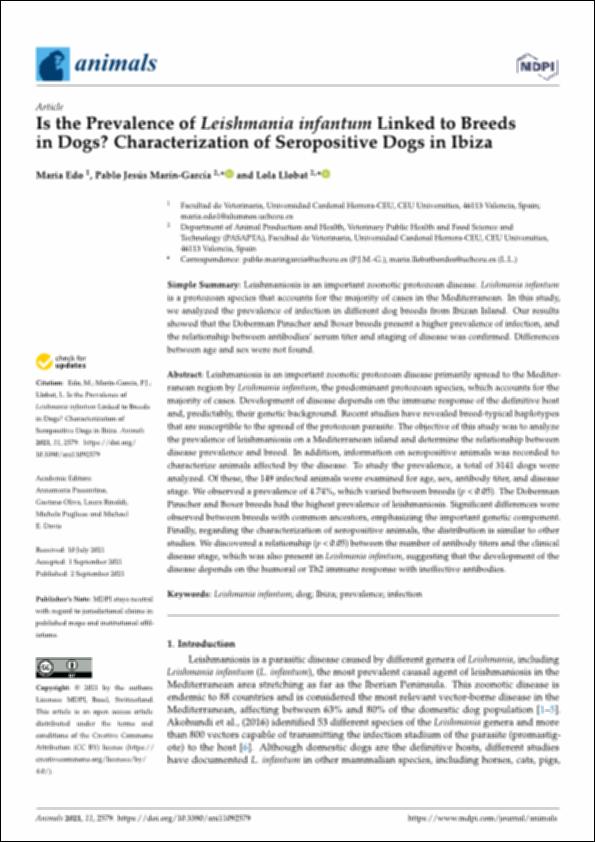Please use this identifier to cite or link to this item:
http://hdl.handle.net/10637/13437Is the prevalence of Leishmania infantum linked to breeds in dogs? : characterization of seropositive dogs in Ibiza
| Title: | Is the prevalence of Leishmania infantum linked to breeds in dogs? : characterization of seropositive dogs in Ibiza |
| Authors : | Edo, María Marín García, Pablo Jesús Llobat Bordes, Lola |
| Keywords: | Perros - Enfermedades infecciosas.; Leishmaniasis.; Dogs - Communicable diseases. |
| Publisher: | MDPI |
| Citation: | Edo, M., Marín-García, P. J. & Llobat, L. (2021). Is the prevalence of "Leishmania infantum" linked to breeds in dogs? : characterization of seropositive dogs in Ibiza. Animals, vol. 11, i. 9 (02 sep.), art. 2579. DOI: https://doi.org/10.3390/ani11092579 |
| Abstract: | Leishmaniosis is an important zoonotic protozoan disease primarily spread to the Mediterranean region by Leishmania infantum, the predominant protozoan species, which accounts for the majority of cases. Development of disease depends on the immune response of the definitive host and, predictably, their genetic background. Recent studies have revealed breed-typical haplotypes that are susceptible to the spread of the protozoan parasite. The objective of this study was to analyze the prevalence of leishmaniosis on a Mediterranean island and determine the relationship between disease prevalence and breed. In addition, information on seropositive animals was recorded to characterize animals affected by the disease. To study the prevalence, a total of 3141 dogs were analyzed. Of these, the 149 infected animals were examined for age, sex, antibody titer, and disease stage. We observed a prevalence of 4.74%, which varied between breeds (p < 0.05). The Doberman Pinscher and Boxer breeds had the highest prevalence of leishmaniosis. Significant differences were observed between breeds with common ancestors, emphasizing the important genetic component. Finally, regarding the characterization of seropositive animals, the distribution is similar to other studies. We discovered a relationship (p < 0.05) between the number of antibody titers and the clinical disease stage, which was also present in Leishmania infantum, suggesting that the development of the disease depends on the humoral or Th2 immune response with ineffective antibodies. |
| Description: | Este artículo se encuentra disponible en la siguiente URL: https://www.mdpi.com/2076-2615/11/9/2579 Este artículo pertenece a la colección "Advances in Canine Leishmaniosis". |
| URI: | http://hdl.handle.net/10637/13437 |
| Rights : | http://creativecommons.org/licenses/by/4.0/deed.es |
| ISSN: | 2076-2615 (Electrónico) |
| Issue Date: | 2-Sep-2021 |
| Center : | Universidad Cardenal Herrera-CEU |
| Appears in Collections: | Dpto. Producción y Sanidad Animal, Salud Pública Veterinaria y Ciencia y Tecnología de los Alimentos |
Items in DSpace are protected by copyright, with all rights reserved, unless otherwise indicated.


